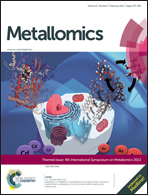The role of glutathione in mercury tolerance resembles its function under cadmium stress in Arabidopsis†
Abstract
Recent research efforts have highlighted the importance of glutathione (GSH) as a key antioxidant metabolite for metal tolerance in plants. Little is known about the mechanisms involved in stress due to mercury (Hg), one of the most hazardous metals to the environment and human health. To understand the implication of GSH metabolism for Hg tolerance, we used two γ-glutamylcysteine synthetase (γECS) Arabidopsis thaliana allele mutants (rax1-1 and cad2-1) and a phytochelatin synthase (PCS) mutant (cad1-3). The leaves of these mutants and of wild type (Col-0) were infiltrated with a solution containing Cd or Hg (0, 3 and 30 μM) and incubated for 24 and 48 h. The formation of phytochelatins (PCs) in the leaf extracts was followed by two different HPLC-based methods and occurred in Col-0, cad2-1 and rax1-1 plants exposed to Cd, whereas in the Hg treatments, PCs accumulated mainly in Col-0 and rax1-1, where Hg–PC complexes were also detected. ASA and GSH/GSSG levels increased under moderate metal stress conditions, accompanied by increased GSH reductase (GR) activity and expression. However, higher metal doses led to a decrease in the analysed parameters, and stronger toxic effects appeared with 30 μM Hg. The GSH concentration was significantly higher in rax1-1 (70% of Col-0) than in cad2-1 (40% of Col-0). The leaves of rax1-1 were less sensitive than cad2-1, in accordance with the greater expression of γECS in rax1-1. Our results underline the existence of a minimal GSH concentration threshold needed to minimise the toxic effects exerted by Hg.

- This article is part of the themed collection: Fourth International Symposium on Metallomics, Oviedo, Spain

 Please wait while we load your content...
Please wait while we load your content...